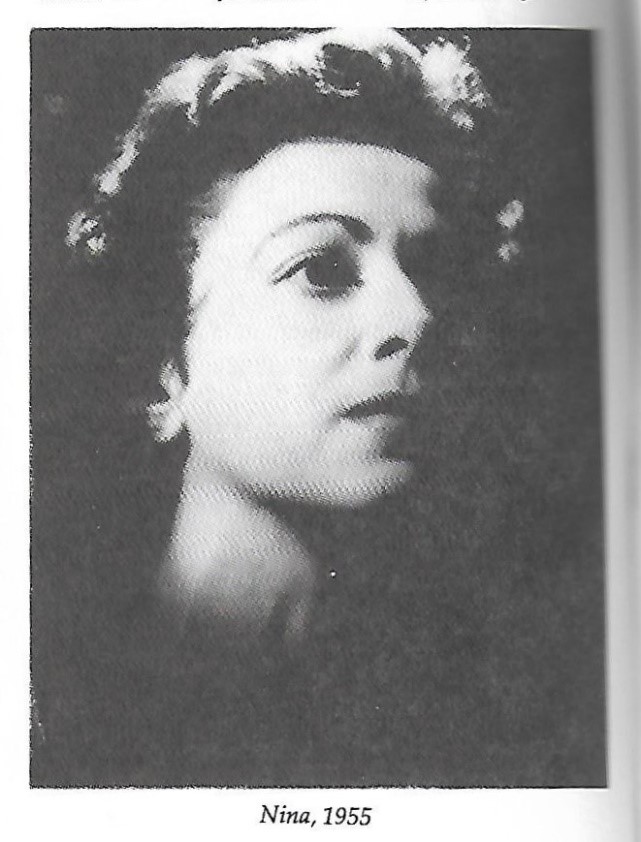- Lauretta Bender: Seminal Psychiatrist & Forgotten Psychedelic Pioneer - April 29, 2021
- Nina Graboi, A Forgotten Woman in Psychedelic Lore - October 21, 2020

November 2012. I have just started my research on the history of LSD and this is my first time in the US. I’m heading to the University of Santa Cruz library where I will be examining a collection at the archives. I am greeted by Nicholas Meriwether, better known for directing the local Grateful Dead collection. I have informed the staff about my visit and there is an air of anticipation on his smile. “I’m here to look at the papers of Nina Graboi,” I tell him. His face lights up and he addresses me as a true Californian. “Dude, she had such an amazing life!”
The collection is unsorted and time-consuming – I may well be the first researcher to plow through it. Out of one box comes a colorful piece of clothing that belonged to Timothy Leary. “Goddam amazing,” whispers Nicholas, as we carefully study it. For me this is the first contact with an icon of the psychedelic Sixties. I do get a slight buzz, but I still don’t really know who Nina Graboi was. Nicholas tells me to grab a copy of her autobiography. Little do I know that One Foot in the Future is going to be a major source for my project.
A Jewish Refugee in New York City

Nina Graboi was born in Vienna at the end of World War I and brought up in the thriving Jewish community of Leopoldstadt. After the Nazis annexed Austria she escaped to London, where she took up various low-paying jobs. Part of her family had relocated to Belgium and during a visit she met her husband Michel. The war broke out and the Maginot Line crumbled. After a year living under German occupation the newlyweds were smuggled into Free France. Eventually they boarded the S/S Wyoming in Marseilles and after an unfortunate six-week spell in a Moroccan detention camp they finally reached New York City.
At last the horrors of fascist Europe were behind them. They quickly set up a textile business that was soon employing dozens of people. Their successful venture enabled them to have their own spacious house built on Long Island. They had two children, Dan and Nicole. They hired a nanny for the kids, a housekeeper, a gardener, and a butler who brought her breakfast in bed every day. “In short, it was the American dream,” Graboi wrote.
But something was amiss. The move to the suburbs created distance from her siblings who had emigrated to Manhattan. While Michel commuted to run the business in the city Nina became a model housewife and entertained her new friends with lavish parties. All the time on the run in Europe she had not really gotten to know her husband. It turned out he was not really the man she hoped he was. The boredom and emptiness of postwar conformity slowly settled in. “I teetered on high heels, wore my hair in the casual-seeming Italian style that was the result of nights spent with fat rollers pinned to my head,” Graboi remembered.
There had to be more to life than this. In her quest for greater meaning she had turned to alternative spirituality and meditation. But in the early Sixties psychedelics started appearing in the pages of Time magazine. She was thrilled by the possibility of experiencing exceptional states of consciousness, even as a woman who had always looked down on “drugs.” Eventually she met and befriended Timothy Leary, the former Harvard professor-turned LSD proselytizer and counter-cultural icon of the decade. The two of them became collaborators in the American psychedelic movement.
Graboi’s psychedelic odyssey offers an intimate account of a woman who fully grasped the transformative power of the psychedelic experience.
Graboi’s psychedelic odyssey offers an intimate account of a woman who fully grasped the transformative power of the psychedelic experience. Before experimenting with psychedelics she freely admitted being middle-class and conforming to the gender stereotypes of her time. But after taking LSD in 1966 her perspective on postwar society was turned upside-down. “What I had once taken for reality now looked like flim-flam. The hypocrisies and delusions in which I, like most people, had spent my life stood naked before me.” In the aftermath of the experience she closed her bank account and divorced her husband, Michel.
The Psychedelic Movement and the Center of the League of Spiritual Discovery
The transformative psychedelic experience led Graboi to become actively involved in NYC’s vibrant psychedelic scene. In September 1966 Graboi accepted Leary’s offer to direct the newly founded Center of the League for Spiritual Discovery in Manhattan, which was set up in a dilapidated Greenwich Village storefront. The League is best remembered for being part of Leary’s own brand of psychedelic religion. At the time the High Priest of LSD was facing a lengthy jail sentence for cannabis smuggling. In an attempt to beat the charges he presented psychedelics as spiritual adjuncts that should be protected by religious freedom.
But what actually happened behind the walls of the Center? Enthusiasts and non-drug users alike could have access to information about psychedelics and join the daily meditation sessions. All this would not have happened without Graboi’s dedication: “As head of the New York Center I could do much to prepare those who were determined to try [psychedelics], discourage those to whom it would be detrimental, and counsel those who were trying to integrate the experience.”
Psychedelic artist Martin Carey once walked into the Center and was taken to its supportive environment:
There was a light machine going in the front and soft Indian music playing, and there were candles and incense… All of a sudden, I felt I was tripping. For a moment I was really scared, and I thought, well, if it has to happen, this is the place for it. Of course as soon as I stopped being scared, it stopped. Richard Alpert was speaking, and there were pictures of Timothy Leary along the wall. The whole room – the whole environment – there was a sense of a Catholic martyr trip about it. I sat way in the back. It was a very large, narrow room […] Sitting in a room like that with a lot of other people who were turning on to a very high level and being drawn together because of it.
The Center was more than a place for psychedelic spirituality. As a hotspot for New York’s counter-culture the League’s attendees were invited to sit on the floor rather than on chairs, which were “as much a badge of the straight world as short hair.” Graboi purposefully decided against a poster telling folks not to litter because it “would bring visions of the police state to the young dropouts’ minds and provoke them to contrary acts.” Instead a staff member drew a psychedelic goddess that featured a much gentler caption – “Don’t be a litterbug.”
Graboi’s involvement with the League was not confined to managing the Center, however. On one instance she gave a talk on psychedelic spirituality at the Riverside Drive cathedral. But the diversity of the crowd made her a little nervous: “The faces that scrutinized me as I stood behind the lectern were young, in their twenties and thirties. Some were open, but reserved. Others betrayed the closed hostility I was familiar with from some of the visitors at the Center.”
But she gradually grew into it and openly joked about her drug use: “Until a year ago I was law-abiding citizen. Then I smoked marijuana and became a criminal.” She eloquently presented the psychedelic experience as a way of easing the perennial fear of death. She made a good impression on some of the attendees who then asked her where they could get their hands on some acid.
Nina Graboi’s Psychedelic Legacy

The story of Nina Graboi’s involvement with the psychedelic movement is significant because it challenges the idea that the psychedelic counter-culture of the 1960s was strictly a man’s world and that women were peripheral figures who were supposed to reproduce gender stereotypes and to be sexually available for men – as Leary’s appetite for womanizing aptly illustrates. To be sure Leary’s influence loomed large at the Center, which was decorated with mandalas and pictures of the High Priest.
The story of Nina Graboi’s involvement with the psychedelic movement is significant because it challenges the idea that the psychedelic counter-culture of the 1960s was strictly a man’s world.
But Graboi was unimpressed by his cult of personality. On one occasion two young men were in the process of repainting the ceiling but they had uncovered large bronze plaques under the plaster. Although Graboi thought that the plaques gave the room a unique charm, the counter-culturists wanted to paint over them because Leary had once told them that “all metal should be returned underground.” She laughed so hard that tears ran down her cheeks.
This anecdote points to another popular misconception surrounding the counter-culture of the Sixties, which was supposedly young, naïve, and oblivious to work. The League certainly drew its share of criticism from the outside for supposedly encouraging illegal drug use – in fact it strictly prohibited drugs on the premises. But some of those critics were confounded upon seeing enthusiastic volunteers helping her refurbish the storefront: “It was a pleasant sight: four long-haired teen-aged boys wearing beads, colorful shirts and patched pants, cheerfully wielding screwdrivers, hammers and saws.” Several critics ended up tempering their views on psychedelics and the League thanks to a woman who was far older than the baby-boomers.

Join us at Sacred Plants in the Americas II
Toward a History of Women and Psychedelics?
The international psychedelic community is becoming increasingly aware of the male-dominated narratives of the history of psychedelics. To be sure psychedelic stars like Leary, Aldous Huxley, Ken Kesey, along with all the male psychiatrists undertaking psychedelic research at the time, are the main actors in most accounts. Is this the product of male bias in the process of history writing? The reality of the gender relations of the time? An unfortunate absence of primary sources? A combination of all the above? In any event, the story of Nina Graboi is proof that these stories are there if we bother look for them.
I would like to thank Ralph Abraham for allowing me to reproduce illustrations of Graboi’s autobiography, and Erika Dyck and Bia Labate for giving me the opportunity to publish this piece.
Art by Marialba Quesada.
Take a minute to browse our stock:
Did you enjoy reading this article?
Please support Chacruna's work by donating to us. We are an independent organization and we offer free education and advocacy for psychedelic plant medicines. We are a team of dedicated volunteers!
Can you help Chacruna advance cultural understanding around these substances?














